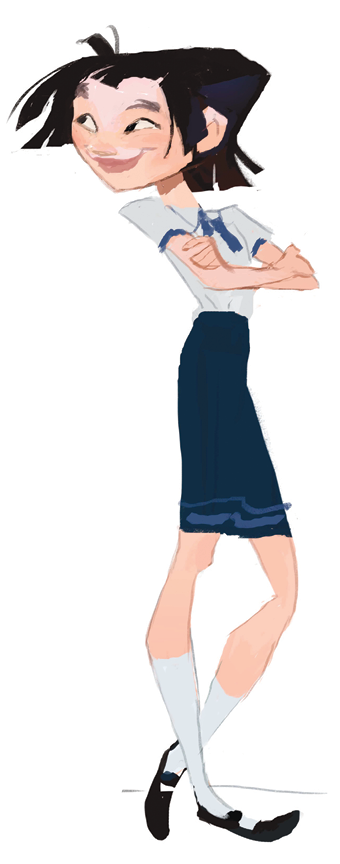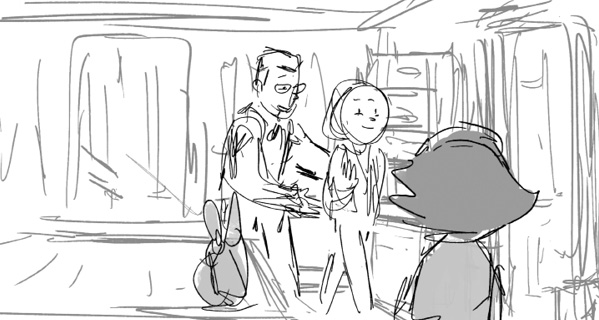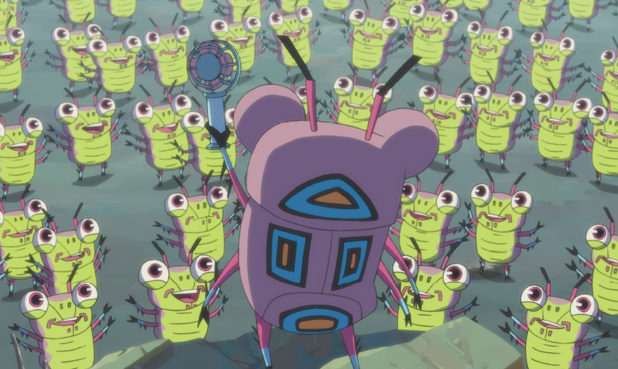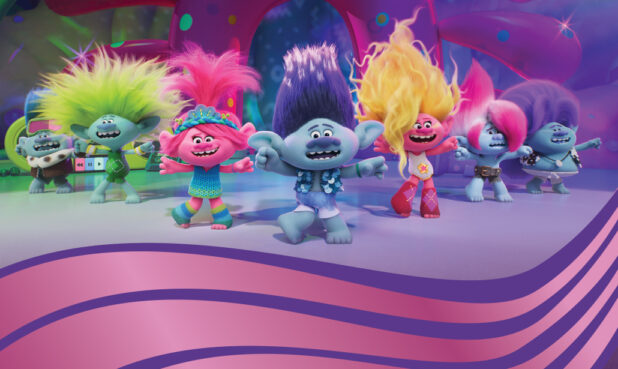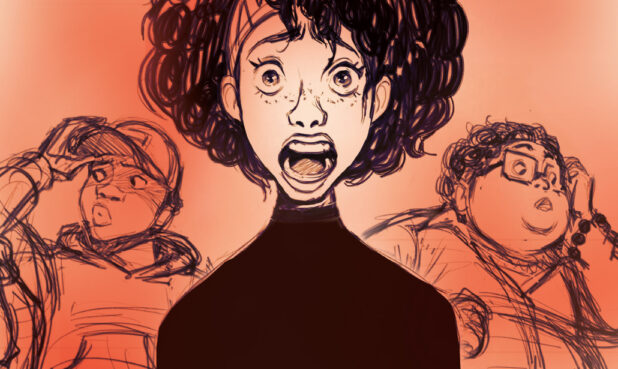When Glen Keane commented on her Ariel fan art, Character Designer Brittany Myers couldn’t believe the man that inspired her path into animation had given her a thumbs up. What happened next, was even more surprising? “The next day, [producer] Gennie Rim reached out to me via Facebook and I got the offer to come onto the project. I was like, is this real?” she says. “He loved that [my designs] had sincerity and felt like living, breathing characters. He liked what I was doing in terms of silhouette and shape.”
Myers describes her style as sculpting in paint, stretching and pushing forms to their limits, sometimes pulling back when she’s gone too far. “When I draw in pencil, I think there’s a subconscious barrier because I know that if I mess up, what if I can’t erase this?” she says, adding that she prefers to work in Photoshop, starting with broad strokes and refining as she continues to work.

The character designer’s first task on the film was to work on Fei Fei, the film’s main character—a spunky, motivated dreamer who is grappling with the loss of her mother. Fortunately, Keane already felt very connected to the character, and together he and Myers worked quickly to establish Fei Fei’s design, leaving some of the details to be tweaked. “Little things like hair, details on the clothing,” says Myers, like “how her sleeves are often covering her palms, almost like a security blanket.”
The entire production team quickly fell in love with the character. “Fei Fei goes through this journey of loss and grief,” says Steven MacLeod, Head of Story. “That was what was special to me. I felt like it was a very universal message of healing and learning to love.”
This genuine connection to the character helped the board artists in their journey to discover the story. “What would Fei Fei do? What would Fei Fei feel? It was interesting to see that chemistry happening. In the beginning of the production, it’s hard to tell who she really is until you live with the character 24/7 for two years. To this day, Fei Fei feels very personal to me,” says Story Artist Hikari Toriumi. “The journey she goes through in the film was something that I can relate to.”
“Fei Fei goes through this journey of loss and grief. I felt like it was a very universal message of healing and learning to love.”—Steven MacLeod
This magical tale follows a 13-year-old girl as she seeks to prove that the impossible is possible, building a rocket to travel to the moon in search of Chang’e, the mythological Chinese moon goddess.
Depicting Chang’e, a ubiquitous character in the Chinese culture (one that Keane likens to the popularity of Santa Claus), proved more challenging and fodder for lively conversation amongst the Chinese artists working at partner studio, Pearl, in Shanghai.
“There was a debate about the Chang’e story because there’s variations in the details,” says MacLeod. “You do your homework, research online and in books but then [also] make our own modern interpretation.”
“You have this character that is still in their evolution stage, they’re still that chrysalis about to emerge as a butterfly—that’s always really exciting,” says Story Artist Minkyu Lee. Fashion Designer Guo Pei inspired and eventually designed Chang’e’s clothes. “It was a huge reference and inspiration of the goddess-like quality that she brings.” Lee says the production team wanted to honor how meaningful this character was to so many people.
“There are so many different interpretations to be had so I kind of researched every avenue, what options there were,” says Myers of the character design process for Chang’e. “How we felt Fei Fei would interpret her for this story. How it relates to her losing her mother and how she may have remembered those stories from her childhood—how she pictures her and built her up in her own mind.”
This dialogue with Pearl influenced the design and story to ensure it was faithful to Chinese culture. “Our leadership always leaned into that and our collaborators, who came from the authentic background of this story, were always the sounding board,” says Lee.
Though the legend is Chinese, Fei Fei’s story is universal. The groundwork in terms of the theme had been lovingly crafted by screenwriter Audrey Wells, whose script was essentially movie ready and just needed to be refined. “How do we best express this story in terms of these themes, these moments and these emotions?” says Lee of the story process that ensued.
MacLeod’s main concern at the outset was the varied locations and characters. “It can start to feel like a fever dream, a little bit like Alice in Wonderland.” He wanted to make sure that the characters continued to grow through every scene. “Each sequence had a purpose to the evolution of the characters,” he adds.
It helped that Keane’s collaborative environment paved the way for a smoother journey of story discovery. “He’ll listen to everybody’s ideas no matter what position they’re in,” notes MacLeod.
“He was always open to new ideas, even from the young artists, and always took time to listen to us and get excited,” says Toriumi. “Glen did this thing [where] he starts making the sound effects. I was pitching and then I start hearing his sound effects coming in. It was very encouraging!”
“It felt very effortless at the time because he was great at describing what it was that he wanted,” adds Myers of Keane’s ability to articulate his ideas artistically, creating a visual shorthand.
“He might draw a little sketch for an expression, then I would take a photo of it and text it to the board artists that [were] at the desks. I’d give them the stats for the scene and which panel and then they would do the fix and process it back to editorial. We’d take an editorial break and they would plug it in and then Glen would watch it and say, ‘wow, that was fast,’ and we would lock the scene,” says MacLeod. “It was a really fun process of having him draw whatever specific expression—that helps throughout the pipeline for the animators to understand what he’s after.”
The difficult part for MacLeod? Doing fixes on Keane’s and Lee’s scenes because “they draw at such a high level of draftsmanship.” However, Keane’s openness to change helped lead by example. “We all revisited each other’s scenes. There was one scene in the movie that every board artist worked on, which isn’t totally typical.”
“I definitely like to think about story musically, to think of story structure as [having] different movements.”—Minkyu Lee
The scene, where the entire extended family is seated around the dinner table, had tricky choreography with dialogue between numerous characters. The story team did several passes on the sequence—one for exposition, another for story and plot purposes, and a third for clarity.
Another unusual aspect of this film—almost every story artist had an opportunity to board a song.
“A good song will have a strong shape to it already,” adds MacLeod “Every song has a different scale to it.” He notes that some have multiple characters, some only a couple. Some are really involved like boarding an action sequence while others, like an intimate duet, have very specific staging and blocking, with characters doing interesting gestures and expressing emotion in their faces. “You try to cast the right board artist for the right song,” he says.
“I definitely like to think about story musically, to think of story structure as [having] different movements,” says Lee, who boarded three songs for the film. “You’re working with creative, inspiring limitations. You have to fit this entire story in the duration of that song. And, oddly that helps, that becomes a really great compass for what the sequence is supposed to be.”

Lee begins with breaking down the lyrics, examining how the structure escalates as the characters figure out their problems and find solutions, while also approaching the process more fluidly, with inspired bursts of unbridled creativity. The balance of the two creating harmony between the music and images.
One of Lee’s highlights while working on the film was boarding a song performed by Phillipa Soo. “I floated this idea of let’s really let her voice soar and kind of pitched a brand-new introduction for the song,” he says. Keane liked Lee’s concept and set up a meeting with the song writers. “And then it happened!” enthuses Lee. “I think that just goes to show how gracious, generous, open-minded and open-hearted of a collaborator Glen is. That was a very exciting moment for me.”
The final elements of the film were completed during quarantine but that didn’t dampen the excited of seeing the sequences come alive through music. “Everybody gets super giddy around the scoring sessions,” says MacLeod, who watched virtually as musicians around the world recorded the final score. “It’s surreal. You get emotional every time.”

